The worlds of folk and pop music (and any other musical genre) are not so separated as purists might wish This is true for both Mike Scott and Kate Bush.
 I was six or seven when I noticed the music in my head. It was there in the classroom, on the football pitch,
at the dinner table, when I went to sleep and when I woke up. And it’s continued ever since.
In 1983 the Edinburgh born Mike Scott
founded the musical vehicle he called The Waterboys with a constantly recasted line-up
(some 60 musicians in 30 years), including fiddler Steve Wickham
[37]
[45],
and saxophonist Anthony Thistlethwaite (now with the Saw Doctors)
[29].
In Adventures of a Waterboy the interview and fan refusing
Scott tells in his own words about his musical career. How he found early
international success with the hit single "The Whole Of The Moon" and the
Waterboys' Big Music, changed direction and became obsessed
with traditional Irish music [20],
recording the critical acclaimed
"Fisherman’s Blues" with accordion player Sharon Shannon and others [48],
disappeared for years in the spiritual community of Findhorn -
before raising from the dead in the new millennium and delivering a string of inspired albums
[27]
[31]
[46].
The book unfortunatly ends too early in 2000. Otherwise it is a
straight-forward, graphic and pleasing autobiography.
I was six or seven when I noticed the music in my head. It was there in the classroom, on the football pitch,
at the dinner table, when I went to sleep and when I woke up. And it’s continued ever since.
In 1983 the Edinburgh born Mike Scott
founded the musical vehicle he called The Waterboys with a constantly recasted line-up
(some 60 musicians in 30 years), including fiddler Steve Wickham
[37]
[45],
and saxophonist Anthony Thistlethwaite (now with the Saw Doctors)
[29].
In Adventures of a Waterboy the interview and fan refusing
Scott tells in his own words about his musical career. How he found early
international success with the hit single "The Whole Of The Moon" and the
Waterboys' Big Music, changed direction and became obsessed
with traditional Irish music [20],
recording the critical acclaimed
"Fisherman’s Blues" with accordion player Sharon Shannon and others [48],
disappeared for years in the spiritual community of Findhorn -
before raising from the dead in the new millennium and delivering a string of inspired albums
[27]
[31]
[46].
The book unfortunatly ends too early in 2000. Otherwise it is a
straight-forward, graphic and pleasing autobiography.
Mike Scott, Adventures of a Waterboy.
Jawbone Press,
2012, ISBN 978-1908279248, pp288, €30.
 The first Penguin Book of English Folk Songs was published
during the so-called second folk revival in 1959, edited by
Ralph Vaughan Williams [44]
and AL Lloyd [38],
its content taken from the journals of the Folk Song Society and thus documenting the first folk revival
100 years ago when collectors started transcribing the traditional, orally transmitted body of songs.
The follow-up volume has been prepared by Steve Roud, founder of the
colossal Folk Song Index
and its Roud number system. The aim is to present the core tradition of English folk song
as reflected in the collections compiled from the 1870s to the 1980s,
with songs which were collected most often, at the same time
present versions that use the (complete) tune and text from the same singer
(with some audio-transcriptions presented here for the first time):
151 songs, barely an overlap with the predecessor, with
sheet music, lyrics and background notes.
There is both the well-known and the rather unfamiliar,
the "Greenland Whale Fishery" and "The Mermaid"
versus the "Bonny Bunch of Rose O,"
(only recently sung by June Tabor [49])
in the first chapter "Soldiers and Sailors."
"Unhappy Love" is much more popular (as is "Songs of Death and Destruction") than "Happy Relationships".
Shanties, work songs, carols and rhymes have largely been omitted.
There is also an introduction about the history of song collecting, singing style, etc.
plus bibliography, discography, indexes of titles, first lines, collectors' and singers.
A great resource and highly recommended by the FolkWorld team!
The first Penguin Book of English Folk Songs was published
during the so-called second folk revival in 1959, edited by
Ralph Vaughan Williams [44]
and AL Lloyd [38],
its content taken from the journals of the Folk Song Society and thus documenting the first folk revival
100 years ago when collectors started transcribing the traditional, orally transmitted body of songs.
The follow-up volume has been prepared by Steve Roud, founder of the
colossal Folk Song Index
and its Roud number system. The aim is to present the core tradition of English folk song
as reflected in the collections compiled from the 1870s to the 1980s,
with songs which were collected most often, at the same time
present versions that use the (complete) tune and text from the same singer
(with some audio-transcriptions presented here for the first time):
151 songs, barely an overlap with the predecessor, with
sheet music, lyrics and background notes.
There is both the well-known and the rather unfamiliar,
the "Greenland Whale Fishery" and "The Mermaid"
versus the "Bonny Bunch of Rose O,"
(only recently sung by June Tabor [49])
in the first chapter "Soldiers and Sailors."
"Unhappy Love" is much more popular (as is "Songs of Death and Destruction") than "Happy Relationships".
Shanties, work songs, carols and rhymes have largely been omitted.
There is also an introduction about the history of song collecting, singing style, etc.
plus bibliography, discography, indexes of titles, first lines, collectors' and singers.
A great resource and highly recommended by the FolkWorld team!
Steve Roud & Julia Bishop (eds), The New Penguin Book of English Folk Songs.
Penguin Books,
2012, ISBN 978-0-141-19461-5, pp542, £25.00.

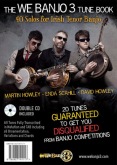 Irish banjo virtuoso Enda Scahill
has two banjo tutorials to his credits
[38]
[47].
His recent offering with his We Banjo 3
collaborators Martin and David Howley [49]
is the tunebook 40 Solos for the Irish Tenor Banjo, split into two complementary
parts (with two CDs respectively). Part #1, "20 Tunes Guaranteed to Help You Win Banjo Competitions,"
provides a nice selection of popular session tunes
which will never be out of place at any fleadh competition
(Martin and David can successfully tell). Part #2,
"20 Tunes Guaranteed to Get you Disqualified from Banjo Competitions", is a selection of
Irish-ish as well as some old-time, bluegrass and minstrel tunes (see the WB3 album)
that Enda has been playing for
years to the delight of many an audience though not generally rewarded by fleadh adjudicators
(Enda can tell). So it is the "Hag with the Money" and Sean Keane's "Castle Jig"
(banjoist Damaris Woods just recorded it [49])
versus Gordon Duncan's "Pressed For Time" and Fintan McManus's "Guns of the Magnificent Seven".
All tunes are note-for-note transcriptions in both standard notation and tablature of the
performances on the accompanying CDs, including all ornamentation, variation and chording
- every single triplet and hammering!
So it is a fine resource for banjo players and an even greater
exposition of how to develop a tune and make a performance more interesting.
Irish banjo virtuoso Enda Scahill
has two banjo tutorials to his credits
[38]
[47].
His recent offering with his We Banjo 3
collaborators Martin and David Howley [49]
is the tunebook 40 Solos for the Irish Tenor Banjo, split into two complementary
parts (with two CDs respectively). Part #1, "20 Tunes Guaranteed to Help You Win Banjo Competitions,"
provides a nice selection of popular session tunes
which will never be out of place at any fleadh competition
(Martin and David can successfully tell). Part #2,
"20 Tunes Guaranteed to Get you Disqualified from Banjo Competitions", is a selection of
Irish-ish as well as some old-time, bluegrass and minstrel tunes (see the WB3 album)
that Enda has been playing for
years to the delight of many an audience though not generally rewarded by fleadh adjudicators
(Enda can tell). So it is the "Hag with the Money" and Sean Keane's "Castle Jig"
(banjoist Damaris Woods just recorded it [49])
versus Gordon Duncan's "Pressed For Time" and Fintan McManus's "Guns of the Magnificent Seven".
All tunes are note-for-note transcriptions in both standard notation and tablature of the
performances on the accompanying CDs, including all ornamentation, variation and chording
- every single triplet and hammering!
So it is a fine resource for banjo players and an even greater
exposition of how to develop a tune and make a performance more interesting.
The We Banjo 3 Tune Book - 40 Solos for Irish Tenor Banjo.
2012, ISBN 978-0-957141117-7, pp80, €20 (www.webanjo3.com).
 Scottish harpist Fraya Thomsen co-founded The Duplets in 2005.
Alex Monaghan wrote on this website: Fraya's tunes on 'Tree of Strings' are
frankly funky, rich and varied.
[38]
[49]
Taigh na Teud (i.e. Harpstring House -
a house near Killiecrankie, reputedly the gathering place of harpers in the 16th century
and where Mary Queen of Scots replaced a broken harp string once)
have now published Fraya's three volumes of original music for the harp,
Puirt Ùra Air A' Chlàrsaich (New Tunes for Harp).
Vol. #1 for beginners is a bilingual book in Gaelic and English, featuring a
page about technique as well as finger placing and plucking exercises,
7 original tunes and the traditional song "Seallaibh curaidh Eòghain".
Likewise, vol. #2 (intermediate players) and #3 (advanced performers) have more of Fraya's pieces.
After all, it is a great collection of neo-Celtic tunes deeply rooted in the Scottish tradition.
Scottish harpist Fraya Thomsen co-founded The Duplets in 2005.
Alex Monaghan wrote on this website: Fraya's tunes on 'Tree of Strings' are
frankly funky, rich and varied.
[38]
[49]
Taigh na Teud (i.e. Harpstring House -
a house near Killiecrankie, reputedly the gathering place of harpers in the 16th century
and where Mary Queen of Scots replaced a broken harp string once)
have now published Fraya's three volumes of original music for the harp,
Puirt Ùra Air A' Chlàrsaich (New Tunes for Harp).
Vol. #1 for beginners is a bilingual book in Gaelic and English, featuring a
page about technique as well as finger placing and plucking exercises,
7 original tunes and the traditional song "Seallaibh curaidh Eòghain".
Likewise, vol. #2 (intermediate players) and #3 (advanced performers) have more of Fraya's pieces.
After all, it is a great collection of neo-Celtic tunes deeply rooted in the Scottish tradition.
Fraya Thomsen, Puirt Ùra Air A' Chlàrsaich Luchd-Tòiseachaidh (New Tunes for Harp Beginners).
Taigh na Teud,
2011, ISBN 978-1-906804-07-7, pp20, £10.00.
Fraya Thomsen, Puirt Ùra Air A' Chlàrsaich Eadar-Mheadhanach (New Tunes for Harp Intermediate).
Taigh na Teud,
2011, ISBN 978-1-906804-08-4, pp16, £10.00.
Fraya Thomsen, Puirt Ùra Air A' Chlàrsaich Adhartach (New Tunes for Harp Advanced).
Taigh na Teud,
2011, ISBN 978-1-906804-09-1, pp16, £10.00.
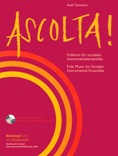 Ascolta! (Italian: Listen!) was the name of an instrumental folk music ensemble that Axel Genannt
looked after at the Music School of Bad Vilbel for seven years.
This compilation features 14 tried and immediately executable arrangements (instrumental without lyrics),
including background infos, as well as suggestions for performance, instrumentation,
variation and improvisation. The volume contains Spanish and Russian
folk songs ("Anda jaleo," "Dorogoj dlinnoju", the latter better known as Mary Hopkins "Those Were The Days"),
a northern German farewall song ("Die blaue Flagge"), a klezmer piece ("Di grine Kusine"),
the Irish "Whiskey in the Jar" with spoon accompaniment, an Argentinian tango,
a French musette walzer, a Bulgarian 7/8 širto. The accompanying CD ROM contains the material
in the keys of C and B and a guitar version - all as pdf files.
Ascolta! (Italian: Listen!) was the name of an instrumental folk music ensemble that Axel Genannt
looked after at the Music School of Bad Vilbel for seven years.
This compilation features 14 tried and immediately executable arrangements (instrumental without lyrics),
including background infos, as well as suggestions for performance, instrumentation,
variation and improvisation. The volume contains Spanish and Russian
folk songs ("Anda jaleo," "Dorogoj dlinnoju", the latter better known as Mary Hopkins "Those Were The Days"),
a northern German farewall song ("Die blaue Flagge"), a klezmer piece ("Di grine Kusine"),
the Irish "Whiskey in the Jar" with spoon accompaniment, an Argentinian tango,
a French musette walzer, a Bulgarian 7/8 širto. The accompanying CD ROM contains the material
in the keys of C and B and a guitar version - all as pdf files.
Axel Genannt, Ascolta!
Breitkopf & Härtel, Kammermusik-Bibliothek 2285,
2012, ISMN 9-790004-503133, 44 S, €26 (inkl. CD-ROM).
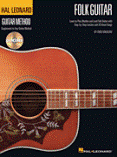 Fred Sokolow
[45]
is at it again. This time with a folk guitar method to teach the basics techniques of
rhythmic back-up such as the Calypso Strum and the Carter Lick and a first approach
to solo playing. Along the way you learn 20 popular songs from the 1950s/60s folk revival
from "Blowing in the Wind" to "Where Have All the Flowers Gone,"
featuring the likes of Cohen, Cotten, Crosby Stills Nash & Young,
[49]
Dylan, Guthrie, Peter Paul & Mary, Seeger ...
The accompanying CD includes 31 tracks for demonstration and play-along.
Fred Sokolow
[45]
is at it again. This time with a folk guitar method to teach the basics techniques of
rhythmic back-up such as the Calypso Strum and the Carter Lick and a first approach
to solo playing. Along the way you learn 20 popular songs from the 1950s/60s folk revival
from "Blowing in the Wind" to "Where Have All the Flowers Gone,"
featuring the likes of Cohen, Cotten, Crosby Stills Nash & Young,
[49]
Dylan, Guthrie, Peter Paul & Mary, Seeger ...
The accompanying CD includes 31 tracks for demonstration and play-along.
Fred Sokolow, Folk Guitar - Learn to Play Rhythm and Lead Folk Guitar with Step-by-Step Lessons and 20 Great Songs.
Hal Leonard HL00697414,
2012, ISBN 978-1-4584-0241-7, pp62, US$14.99 (incl. CD).
 Celtic Classics in the Easy Guitar series features 30 popular songs from Ireland and Scotland
with stave notes, tablature, chords, lyrics, as well as suggested strum and pick patterns.
The volume is kicking off with parlour songs by Thomas Moore & Co.,
followed by folk songs such as "Sally Gardens" to the more cheerful "Lanigan's Ball".
It is a nice selection, and fine that the classics also include pieces way off the beaten track.
For example, "Be Thou My Vision" (Irish: Bí Thusa 'mo Shúile) is a hymn, whose original
Irish text is attributed to the 6th century poet Dallán Forgaill,
which has been translated into English by Mary Elizabeth Byrne
in 1905 and versified by Eleanor Hull in 1912.
In 1927, Welsh composer David Evans set it to the music of the Irish folk song, "Slane,"
which deals with St. Patrick challenging the pagan High King at Slane Hill in 433.
The hymn has been translated back into modern Irish several times,
the most popular being Aodh Ó Dúgain's recorded by his grand-daughter Moya Brennan
[49].
Celtic Classics in the Easy Guitar series features 30 popular songs from Ireland and Scotland
with stave notes, tablature, chords, lyrics, as well as suggested strum and pick patterns.
The volume is kicking off with parlour songs by Thomas Moore & Co.,
followed by folk songs such as "Sally Gardens" to the more cheerful "Lanigan's Ball".
It is a nice selection, and fine that the classics also include pieces way off the beaten track.
For example, "Be Thou My Vision" (Irish: Bí Thusa 'mo Shúile) is a hymn, whose original
Irish text is attributed to the 6th century poet Dallán Forgaill,
which has been translated into English by Mary Elizabeth Byrne
in 1905 and versified by Eleanor Hull in 1912.
In 1927, Welsh composer David Evans set it to the music of the Irish folk song, "Slane,"
which deals with St. Patrick challenging the pagan High King at Slane Hill in 433.
The hymn has been translated back into modern Irish several times,
the most popular being Aodh Ó Dúgain's recorded by his grand-daughter Moya Brennan
[49].
Celtic Classics - 30 Songs Arranged in Standard Notation and Tablature.
Hal Leonard HL00703387,
2012, ISBN 978-1-4584-4078-5, pp62, US$14.99.
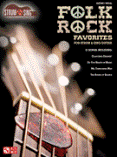 Folk Rock Favourites in the Strum & Sing Series for Easy Guitar
is a concise collection of just lyrics and simple chords so you can strum and sing your favorites:
31 classic folk rock songs from "Brown Eyed Girl" (Van Morrison) to "Teach Your Children" (Crosby Stills & Nash).
[49]
Of course, there is Dylan ("Knockin' on Heaven's Door") and The Byrds ("Mr Tambourine Man"),
Donovan ("Catch The Wind"), Arlo Guthrie ("City of New Orleans)",
Cat Stevens ("Morning Has Broken"), Simon and Garfunkel ("Sound Of Silence"),
but also Janis Ian's "Society's Child", Leonard Cohen's "Suzanne"
and the Beatles' "You've Got to Hide Your Love Away".
Folk Rock Favourites in the Strum & Sing Series for Easy Guitar
is a concise collection of just lyrics and simple chords so you can strum and sing your favorites:
31 classic folk rock songs from "Brown Eyed Girl" (Van Morrison) to "Teach Your Children" (Crosby Stills & Nash).
[49]
Of course, there is Dylan ("Knockin' on Heaven's Door") and The Byrds ("Mr Tambourine Man"),
Donovan ("Catch The Wind"), Arlo Guthrie ("City of New Orleans)",
Cat Stevens ("Morning Has Broken"), Simon and Garfunkel ("Sound Of Silence"),
but also Janis Ian's "Society's Child", Leonard Cohen's "Suzanne"
and the Beatles' "You've Got to Hide Your Love Away".
Folk Rock Favourites for Strum & Sing Guitar.
Hal Leonard HL 02501669,
2012, ISBN 978-1-60378-346-0, pp76, US$9,99.
Kate Bush had been raised on both classical and folk music in her native Kent. She instantly became famous after releasing her first single in 1978, the number one hit "Wuthering Heights," written only on the eve of going into the studio: The song wasn't directly inspired by reading Emily Brontë's novel of 1847, but rather by catching the final ten minutes of a 1970 movie adaption starring Timothy Dalton.

In 1979 she took her songs on the "Tour of Life," an organically realised theatrical production and hydra-headed beast with several distinct faces: music, movement, poetry, mime, burlesque, magic and a continuous parade of eye-popping visual stimuli.
An experience never been repeated. Afterwards she went into the studio and never came out again, having been rarely sighted on stage and if so as guest performer only.
Her musical output is typical for the early 1980s. She became intrigued by the idea of juxtaposing the clinical sound of cutting edge technology with the exposed nerve ends of raw human emotion, of combining a machine-like chilliness with a warm, human presence.
However, there is also much resonating with the folk tradition. Her mother sang Irish folk songs, her brother Jay played in a folk band, and Paddy played concertina for Morris dancers and worked for the English Folk Dance and Song Society. Her favourite music included the Bothy Band,[30] Bert Lloyd,[38] and Kate and Anna McGarrigle.[45]
Kevin Burke[43] frantically fiddled on "Violin". "Babooshka" had been loosely inpired by the folk song "Sovay". Members of Planxty[30] and the Chieftains[48] were playing Bill Whelan's[42] arrangement for "Night of the Swallow".
Bush was well ahead of the game in incorporating Celtic textures into her music. During the "Hounds of Love" sessions she recorded versions of the traditional songs "My Lagan Love" and "The Handsome Cabin Boy". Her own "Jig of Life," based on a Greek tune, was recorded with Donal Lunny,[37] Liam O'Flynn,[27] John Sheahan[39] - and one Charlie Morgan playing both bodhrán and lambeg drum.
The choral section of "Hello Earth" had been taken from the Georgian folk song "Zinzkaro," heard on the soundtrack of Werner Herzog's film "Nosferatu". The following album "The Sensual World" featured harpist Alan Stivell,[41] Davey Spillane[11] piping vaguely Eastern melodies, and the female Bulgarian singing trio Bulgarka. When Donal Lunny compiled his "Common Ground" album, featuring contemporary artists singing Irish sings, Kate Bush sang "Mná na hÉireann" (Women of Ireland), an 18th century poem set to music by Seán Ó Riada.[28]
You never understood me, you never really tried, Kate Bush once sang, as if addressing the British tabloid press. Because of? There was no comparable artist on the British scene at that time: a young, beautiful female who wrote and performed her own words and music to great popular and artistic success.
Bush was also strongly protecting her privacy and creating a sense of mystique. Graeme Thomson, author of "The Resurrection of Johnny Cash - Hurt, Redemption, and American Recordings",[45] thus has to acknowledge that Under the Ivy doesn't promise to supply all the answers. These are snapshots of Kate Bush's musical career and personal life, piecing together like a jigsaw. Though it has never been done so thoroughly and thoughtful. The updated paperback edition, including a concise analysis of Bush's art, has been revised, and there is a new chapter covering the period between 2010 and 2012.
Like Kate Bush, the US American singer Eva Cassidy was avoiding the limelight, never been comfortable with live performances, and enjoyed working in the studio. Though contrary to Kate's flamboyant personality, Eva was shy, introverted, extremely self-critical, melancholic and troubled all of her life: I don't need to be famous, she said, and little wonder she never achieved any fame during her short lifetime.
Eva's grandfather Karl came from the German spa town Bad Kreuznach, where his daughter met an American soldier (whose second cousin, actor Henry Gibson played the Nazi chief in "Blues Brothers"). Eva Cassidy was born in 1963 in Washington DC.

On April 2, 1978 Eva had her first ever performance with the family trio, her brother Dan on the fiddle and her father Hugh on mandolin and electric bass, at the Fleet Reserve Club in Annapolis, Maryland.
Eva started performing regularly at weddings and bar mitzvahs with a Top 40 band, even played heavy metal and prog rock, but soon she began to realize that she created her best work alone, only supported by the small line-up of the Eva Cassidy Band.
Not only that Eva had a preference for songs that lamented death and lost love ...
So it was difficult to find a label and make a record. Her music was also much too diverse. Eva responded by saying that she liked to sing songs she loved and that all she knew was the difference between a good and a bad song.
In 1993 she won a Wammie for Best Female Vocalist for her collaboration with the Godfather of Go-go, Chuck Brown, and an album with jazz and pop standards. The year after she was asked to sing at the award ceremonies.
That nearly was it. Eva played her final gig at the sports bar in Annapolis in July 1996:
Shortly after she was diagnosed with cancer and passed away in November 1996.
However, the story only begins here. At the next Wammies ceremony her parents were presented with several awards on behalf of Eva. 8 posthumous albums to date have been released from master and demo tapes, chart success in the UK came in 2000, afterwards in Europe and then the US. (Eva Cassidy sold more than ten million albums and was number 5 in Amazon's Top 25-selling CDs in the site's 10 year history).
Figure skater Michelle Kwan chose her version of "Fields of Gold" for a routine at the 2002 Winter Olympics and won bronze. Even a musical about Eva's life was staged in 2004. However, in the backwash of her success came arguments and legal disputes over money and much hurt for family and friends.
For the authorised biography "Eva Cassidy: Songbird" the family lawyer assisted in arranging all the interviews: The book was designed to promote a positive image of Eva, essentially little more than a PR exercise. Behind The Rainbow though claims to be an investigating and enlightening biography, and sure it is. Dutch journalist Johan Bakker took to the task, interviewed Eva’s friends, colleagues and family and evaluates Eva's brief performing career and her posthumous fame. They story behind the voice - a touching account not only for Eva Cassidy aficionados!
Eva Cassidy's ancestors at her father's side immigrated from Ireland to the USA (she also had the Irish street hit "Danny Boy" in her repertowre), which would be a stupid explanation to explain her musciality, but gives me a fine bridge to the next feature.
The essay collection Ancestral Imprints is about the history and practice of recording Irish traditional music and dance in both Ireland and the US, from 19th century manuscripts to audio and video recordings. The volume traces imprints, facts, the footsteps in the sand, from nearly three centuries.
Two framing essays: Susanne Ziegler, archivist at the Berlin Phonogramm Archiv, examines the wax cylinder recordings made by Richard Henebry in Ring, Co. Waterford, in 1905. Ethnomusicologist Philip Bohlmann[26] somehow discusses the alpha and omega - from Thomas Moore, Beethoven and Stephen Foster to Dustin the Turkey, the Irish contestant at the 2008 Eurovision. The other 11 essays have been written by practising traditional Irish musicians (unfortunatly no info about the authors are given).

Lisa Morrissey has explored Patrick Weston Joyce[27] (1827-1914) and his regional collection of Limerick tunes. As many other collectors Joyce transcribed the tunes (which he remembered from his youth), made alterations to song texts (especially where he found the language offensive) and had them harmonised for piano players.
On the other hand, Angela Buckley investigates the music manuscripts of Mayo farmer and fiddler Philip Carolan (1839-1910), a snapshot of the repertoire of a fiddle player in rural Ireland. Interestingly, four out of five are Irish tunes, but the rest comes from the Western art and popular music repertoire (waltzes, quadrilles, country dances, polkas, song airs).
Paul de Grae revisits the traditional Irish musician and tune collector Captain Francis O'Neill, the Irish-born emigrant who became chief of police in Chicago and collected tunes from Irish musicians and published them in his "The Dance Music of Ireland" (1907). Here he looks at O'Neill's experiences in America before his move to Chicago in 1870: he was steward on San Francisco-Honolulu trips and a shepherd in California's Sierra Nevada mountains, where he picked up the reel "Far from Home" and the hornpipe "Off to California" from his shepherding partner.
The titles are probably O'Neill's own invention, and both belong to the standard repertoire of traditional Irish sessions around the world today. O'Neill purchased an Edison machine to listen particularily to piper Patsy Touhey's recordings. Jimmy O'Brien Moran compares the styles of Irish and American-Irish pipers such as Touhey and looks at the advent of recording technology around 1900.
Daithi Kearney discusses radio broadcasting, especially investigating the impact of Seán Ó Riada[28] (1931-1971) and his radio programme "Our Musical Heritage," which was about recording musicians in their local area. He examines the paradox that it was heightening the awareness of regional styles but also worked as a force of homogenisation.
Susan Moltherway examines the impact of the recording process on contemporary song performance. These days a recording is the amalgamation of many recorded sounds which have been digitally altered through the effects and processors to achieve the desired result. She observes commercial recording trends by choosing ...
The editor Thérèse Smith is quite proud that this book is unique, being a multi-authored volume about traditional Irish music centred around one conceptual theme. Indeed, it puts some scholarly attention to subjects previously not covered in detail. It features many pictures and tunes (in stave notes), including a bibliography and several indexes. Worth browsing through and reading one article or the other!
Now let us change location for good. From Ashgate, who published the "The Ashgate Research Companion to Japanese Music,"[38] recently came An Introduction to Japanese Folk Performing Arts. It's author, Terence A. Lancashire, observed that thousands of festivals are held in the Japanese archipelago with presentations of various forms of entertainments, ritual and secular dances and theatres whose histories can date back to the Japanese Middle Ages, which represent a world that contrasts radically with that more readily concerned with modern commerce and technology. It is an alternative, less familiar face of Japan begging greater public attention.
The diversity of amateur entertainments, in Japan collectively referred to as Folk Performing Arts, challenges any folklorist when attempts are made to classify them or, more fundamentally, to make sense of their variety. Lancashire takes up the challenge, following the classification and terminology proposed by folklorist Honda Yasuji.

Part 1 of the book discusses the historical background to the Japanese Folk Performing Arts.
Lancashire identifies major performance types:
shukufuku gei: celebratory entertainments (comic dialogue and monologue, celebratory instrumental ensembles);
Lancashire provides his introduction in a short but comprehensive outline of 100 pages. It is a refreshing reading - though an academic, seemingly dry subject -, especially when relating his experiences of seeking out performances - with confused aims of ritual expression and tourist promotion.
Part 2 of the volume is a reference section and "Directory of Important Japanese Folk Performing Arts," providing brief descriptions of the content of the performances and where and when they are performed. So if you go to Japan and if you are interested in traditionals arts and performances be sure to have Lancashire's book with you. It is both an academic text and a guide book.
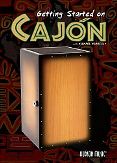
Michael Wimberly, Getting Started on Cajón. Hudson Music HL101797, 2012, ISBN 978-1-4768-1214-4, pp31, US-$19.99 (Book/DVD).
Photo Credits:
(1ff) Book Covers
(from website/author/publishers).